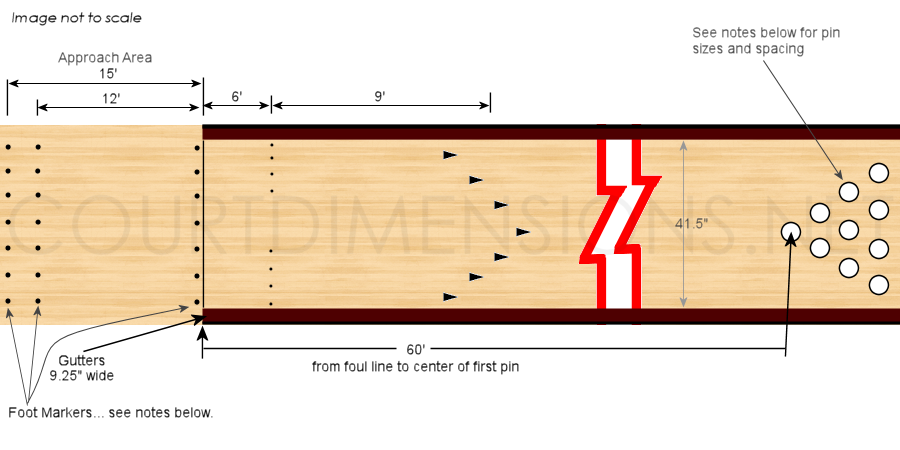Bowling Lane Dimensions
Bowling Lane Dimensions & Measurements
The Bowling Lane & Pins
Bowling is a fun indoor sport that the entire family can enjoy. But have you ever wondered about how big and long those lanes are? Or what about the size of the pins and how they are spaced? Check out the chart above for all the answers, or read on about some bowling fun facts.
Quick Facts About Bowling Lane Dimensions
How far apart are bowling pins spaced?
There are 12 inches between the bases of the bowling pins.
How tall are bowling pins?
Bowling pins are 15 inches tall.
How wide are bowling pins?
There are very specific widths set due the unique shape of a bowling pin. At the base, it is 2.25″ wide. At the waist, or the widest point, it is 4.766″ inches wide. The neck is 1.797″ wide.
What are the dots and arrows on a bowling lane?
They are guides to help you get a strike (or knock down all ten pins with a bowling ball the first time).
How far apart are the dots and arrows?
Each bowling lane has 39 boards that are about one inch wide each. The center board of the lane is considered Board #20. The center arrow and center dot are placed on Board #20. Each arrow and dot to the left and right are placed on the fifth board from Board #20. This means you’ll see three arrows and dots on each side of the center arrow and dot, and they are spaced about five inches apart from each other.
What is the foul line?
Bowlers may not touch or cross the foul line after they’ve released their ball. It is typically one inch wide.
How wide is the bowling lane?
It is usually 41.5″ wide but there is a variance of 1/2 inch either way.
How big are bowling balls? How much do bowling balls weigh?
They are 8.5″ in diameter. Their weight depends on the strength of the player but they never exceed 16 pounds.
Bowling's Timeless Legacy - From Ancient Rituals to Modern Pastime
Few athletic pursuits can claim origins dating back as far as the sport of bowling. What began as ritualistic games in some of humanity’s earliest civilizations has endured across millennia to become a beloved modern pastime around the globe.
Evidence suggests some form of tossing spherical objects at targets arose organically across multiple ancient cultures. Archaeological finds reveal remnants of what appear to be primitive bowling balls from 5,000 years ago among artifacts from ancient Egypt, making it one of the world’s oldest traceable games. The Greek historian Herodotus wrote of the Lydians in Asia Minor having invented a game remarkably similar to modern bowling around the 5th century BC.
These early incarnations often involved religious rituals, such as the Polynesian ceremony of rolling sculpted discs at fixed stone idols. Variations ultimately spread across the ancient world, from the Germanic/Scandinavian tradition of tossing stones at staked sticks, to Roman legions competing at a target version using handheld spheres.
Two distinct bowling disciplines emerged – “pin bowling” aimed at knocking down arranged objects, and “target bowling” where accuracy at hitting a mark scored points. Examples of target bowling’s continued evolution include modern games like bocce, bowls, pétanque and Cherokee marbles. Meanwhile, pin bowling persisted in Europe with games like nine-pin skittles played on greens, courtyards, or cleared outdoor alleys.
It wasn’t until the mid-19th century that truly modern, standardized pin bowling took shape, centered around 10-pin configurations indoors. In 1841, the first permanent indoor bowling lane opened at Sharkey’s Saloon in New York City. Within decades, uniform rules, balls, pins, lane surfaces and other equipment innovations solidified pin bowling as an American institution.
The 20th century witnessed bowling’s explosion in popularity driven by working-class urban appeal, invention of mechanized pinsetters and late 1950s television broadcasts. Plastic resin balls enabled brighter colors and more consistent ball production. Internationally, nine-pin and ten-pin styles proliferated, with organizations like the World Bowling association forming in 1952.
Today’s global bowling community of over 100 million participants across every continent stands as a remarkable through-line tracing back to ancient ritual practices across early civilizations. From the ancient Egyptian and Roman root games, to medieval European lawn bowling variations, all the way to sleek modern bowling center experiences – the simple act of rolling a sphere at targets endures as a timeless sporting constant.
Court and field dimensions for all types of sports.
Whether you’re mapping out practice drills, preparing for the big game, or just a sports fan looking for information on rules and regulations – we’re here to help. We are happy to provide measurements and layouts of sports playing areas – from the basketball court to the gridiron to the bowling lane!
Get details for sports like football, softball, basketball, volleyball, badminton, bowling, soccer, tennis, baseball and more. No more guessing on boundary lines or goal sizes. We have diagrams and dimensions for high school, college, professional, and international levels for most sports.
Looking for the precise measurements of the basketball lane or badminton net? Need to know the distance between bases on a baseball field? Want to map out the full soccer field lines from penalty areas to corners? Our field guides break it all down in easy-to-reference formats with visuals.
CourtDimensions.net makes comparing different sports a breeze too. See at a glance how court and field sizes differ between basketball, volleyball, badminton, and tennis. Quickly visualize the scale difference between a high school basketball court and one the pros play on.
Whether for coaching strategy, recreational play, or just understanding the nuances of your favorite sports – check out CourtDimensions.com’s diagrams and measurement data.

